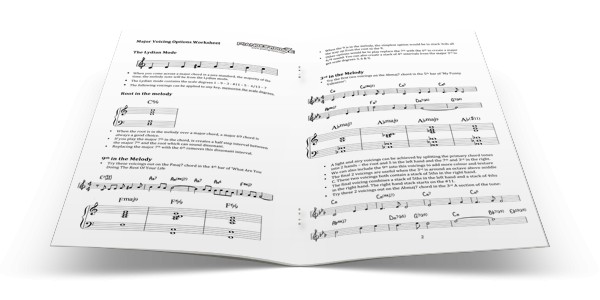To become a skilled jazz pianist it is essential to establish an effective daily jazz piano practice routine. If you are new to jazz piano, figuring out what to practice can be a daunting task. In this post we will explore the essential components of a daily jazz piano practice planner and how to allocate our time to achieve the best results.
## Why practice jazz piano every day?
Jazz pianists must be able to create solo piano arrangements, improvise spontaneous melodies, and provide accompaniments in a variety of styles. This can only be achieved through commitment, daily rehearsing, and most importantly, knowing how to practice jazz piano.
Download a **free beginner practice planner PDF** for learning the foundations of jazz piano. This practice planner contains the 6 most important theory areas for new jazz piano students to drill each day:
[](https://pianogroove.com/resources/foundations-practice-guide/)
**[DOWNLOAD PDF](https://pianogroove.com/resources/foundations-practice-guide/)**
#### The benefits of a complete jazz piano practice schedule
Having a comprehensive practice schedule provides a focused strategy to run through theory drills and get the most out of our practice time.
Each PianoGroove practice planner contains 6 theory exercises and a variety of drills. Remember that it’s not the length of our practice time that will get us the best results, it’s what we can accomplish during that time.
By following the guidance in this post you can learn to practice more efficiently, regardless of your current skill level and ability.
#### Daily jazz piano practice routine
A common pitfall for jazz piano students is to spend all of their practice time working on a single topic or theory area. The better approach is to dedicate between 5 and 15 minutes to a single theory drill, and then move onto the next exercise.
Here is a practice routine PDF which covers the beginner theory topics, download a copy here.
If you have 30 minutes to practice, you can spend 5 minutes on 6 different theory areas. Alternatively, if you have 1 hour to practice you can spend 10 minutes on each of the 6 drills. 5 or 10 minutes might not seem like much time but by revisiting the drills on a daily basis you will see rapid improvement by following this practice method.
### How to create a jazz piano practice planner
At PianoGroove we have numerous PDF practice planners to guide students through the most important theory areas. Each of our practice planners build upon the last one and they should be studied in the following order:
* Jazz Piano Foundations
* Extended Chord Voicings
* Rootless Left Hand Voicings
* Altered Harmony & USTs
Once these theory areas have been mastered we can create our own practice plans based on the sounds that we like and the direction in which we want to take our sound.
When creating your jazz piano practice routine there are 3 important elements that you should incorporate into your practice time on a daily basis:
#### 1) Theory – Chord Voicings & Progressions
It is essential to develop your musical intellect so that you understand the construction of jazz piano chord voicings. It’s also important to understand the harmonic role and function of chord voicings within common progressions such as 251s and 36251s. Simply put, the richer our chord voicings, the richer our jazz piano playing will sound. A jazz musician is only as good as his chord voicings.
When we find a chord voicing or chord progression that we like, the first step is to memorise the numeric construction in terms of scale degrees. The next step is to take the voicing around all 12 keys, and the final step is to apply the voicing to the tunes that we are playing.
Whole step 251 drills are useful for taking a chord progression around all 12 keys:

8 - 251 Drill For Beginners
Lesson Chapters
In our jazz foundations practice guide we cover triads, 7th chords, and the 251 progression. In the chord extensions practice planner we introduce 9ths, 11ths, and 13ths. Finally in our altered harmony practice planner we drill the altered tones (b9, #9, #11, #5/b13) in common progressions such as the 251.
Major 251s and minor 251s are the most common and important chord progression in jazz and we need to be able to play these progressions and voicings on demand. Check out the lessons on the major 251, rootless major 251 and the minor 251. When we can play these progressions comfortably, it is much easier to read and interpret lead sheets and jazz standards.
Once these theory areas have been mastered we can start to explore substitutional harmony, block chords, quartal voicings, and other more advanced voicing techniques.
#### 2) Learning New Tunes
For jazz pianists, learning to play from a lead sheet is a crucial skill which demands a lot of practice; particularly for students coming from a classical background. Try to avoid playing a single note melody in your right hand while playing root position 7th chords in your left. This is not how we voice chords for solo jazz piano performance. Instead we must use the concept of spread voicings.
To arrange a lead sheet for solo piano we must be comfortable with the concept of spread voicings which can also be referred to as shell voicings. To construct a spread voicing, we play the root note of the chord with our left hand in the lower registers of the piano, we play the melody with our right hand, and we ‘voice’ the 3rd and 7th of the chord in between.
The 3rd and 7th of the chord can be played with either hand, and often this role will be shared between both hands to achieve an even spread of notes on the piano and balanced sound in our voicings.
Once we are comfortable with R-3-7 spread voicings we can then introduce chord extensions, alterations, and substitutions to create more interesting colours and textures.
#### 3) Ear Training, Transcription, & Improvisation
Ear training is an important part of a well-rounded jazz piano practice schedule. This is the ability to hear melodic and harmonic sounds and imitate them without the use of sheet music. We should dedicate a small proportion of our daily practice time to ear training.
Check out the ear training exercises in the PianoGroove community area. This forum section contains 150 exercises for beginner, intermediate, and advanced level.
Ear training leads onto the process of transcription where we emulate and play along our favourite performances and recordings. Transcription is the most effective way to learn melodic material and phrases for improvisation and also to develop a sense of jazz phrasing and swing feel. Check out the course on how to transcribe by ear and also the transcription studies in the forum area.
Once we have learnt a handful of common 251 lines we can start to practice improvisation over common chord progressions such as 1625s and 3625s. These 2 progressions create a repeating cycle which are great for practicing improvised material. The final step is to incorporate our transcribed material into the tunes that we are playing.
Improvisation is something that should be incorporated into your jazz piano practice regimen every time you sit down at the piano. Understand that ear training and transcription are an essential part of learning to improvise and follow the guidance and exercises in the PianoGroove community area.
### Jazz piano practice tips
Let’s finish this post with a summary of the most important aspects of jazz piano practice:
Always keep in mind that **slow practice is the most effective**, if we can’t play something accurately at a slow speed then we cannot play it accurately at faster tempos. The wise musician practices slowly, the wiser musician practices even slower.
**Split your practice time into small chunks** focusing on different theory areas. Instead of spending 1 hour on a single theory area, split this into 4 blocks of 15 minutes, or 6 blocks of 10 minutes, each focusing on a different drill or exercise.
Use the **circle of fifths** to ensure that you are practicing equally in all of the keys, especially your weak keys. Start at different places on the circle so that you are not always starting in C major. This applies to scales, licks, voicings, and chord progressions.
Record yourself playing jazz standards and **listen to yourself** afterward to evaluate and keep track of your progress and also to deeply analyse your playing and identify areas for improvement.
Finally understand that **learning jazz is a life long journey** and it will take time. Don’t expect for it to happen overnight. You will never get to the point where you have ‘learnt everything’ – there is always more to learn. Instead of always focusing on the ‘end result’, enjoy the journey you are taking.
Happy practicing!




Leave a reply